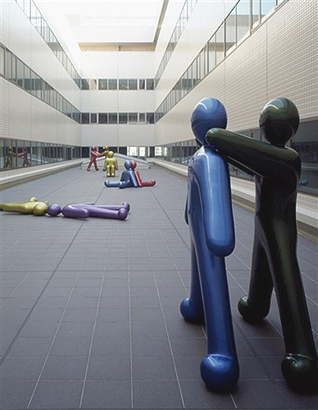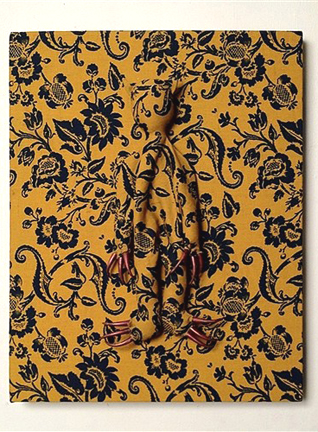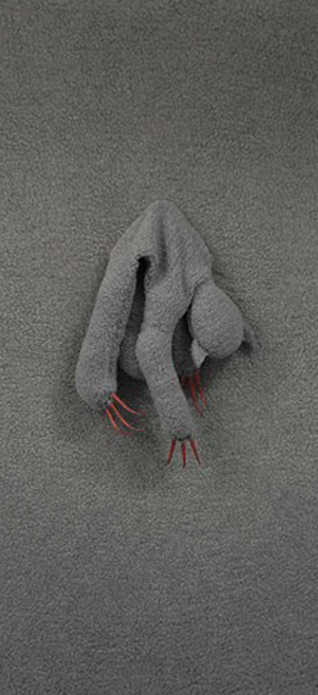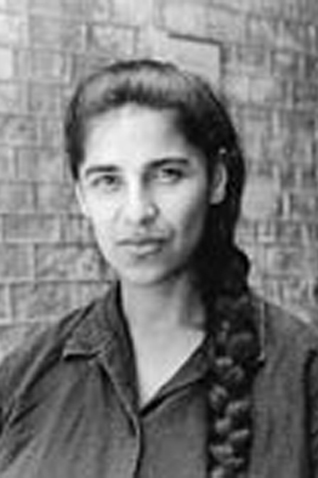Art
Hiding Out:
Artist Permindar Kaur
Interview with RUTH WILBUR
Since the 1990s, Nottingham-born artist, Permindar Kaur, has created sculptural objects and installations that explore the territory of cultural identity, home and belonging.
She does this by apparently innocent means, invoking childhood and domestic spaces. Little figures and animals fashioned in soft fleece resembling half-stuffed toys are the players in her game.
However, these are far from sentimental trophies; the comfort of fabric is checked by the cold contours of copper and steel. Her toys are armed with claws, horns and beaks, belying their apparent vulnerability and giving them an air of comic menace.
Others disappear against identically coloured or patterned backgrounds, an elaborate game of hide-and-seek perhaps, or a strategy of camouflage or self-negation?
Adaption, mimicry and mirroring: strategies of integration and assimilation.
In another group of works, doorways deliberately screened or blocked negate the idea of welcome or the homely.
This is the first major exhibition of new work produced over the last ten years by an artist whose concerns with cultural exclusivity remain as pertinent as ever.
Here, Permindar Kaur talks to AxisWeb’s Ruth Wilbur about her interest in child-like objects, working in the public realm and her solo exhibition 'Hiding Out' at Djanogly Gallery in Nottingham.
Q - Ruth Wilbur: I’m reminded of my childhood when looking at your work. It takes me back to a time when I was much smaller and more vulnerable and the world seemed a lot bigger.
A - Permindar Kaur: I’ve always been interested in using child-like objects or items that referred to childhood in my work. I started exploring this whilst I was a student at Sheffield Hallam University. The works made for my degree show were like oversized toys - a large toy cart, a see-saw and a pair of elephants, simple, generic, easily identifiable forms that we can all recognise and relate to.
The objects around us are what inform and shape who we are and who we become. I find it interesting that toy-like forms can invoke strong feelings in us. My practice started with toys and objects that were a mix of my British and Sikh-Indian heritage. I didn’t want to use real objects as that would place them too firmly in the world we experience here and now, so I made simple representations of objects out of clay and wood, developing my own visual language.
Q: ‘Camouflage', 2012, is a series featuring animal-like creatures fixed to matching grounds. Can you tell us about this series?
A: Yes, more recently, my practice has shifted towards animal forms, work that includes figures with long claws, horns and antlers. I've been exploring ideas of visibility and vulnerability. The figures are unstuffed and defenseless; the softness of the fabric draws us in while the sharpness of the claws makes you question whether you should get so close.
The series ‘Camouflage', 2012, is in many ways about ‘fitting in’. In each of the three canvases, a clawed figure was made from the same material as the background, there is a sense of futility and it’s evident that the figures are hopelessly failing to blend in to the surface.
'Untitled - 3 Figures’, 2013, is another series that again features similar animal-like forms but this series explores scale, awkwardness and difference. The three large grey figures are squashed into canvases too small for them. One has large horns, the other antlers, but the third has no sharp protrusions. We are left pondering what this figure is missing – horns, antlers or something completely different.
Q: Tell us about the materials that you work with. 'Untitled - 3 Figures', 2013, is constructed from the unusual combination of copper & fleece...
A: I enjoy using contrasting materials. In the past this has been rubber and copper, steel and wood or terracotta and glass. It's interesting working with materials which have very different qualities and exploring how they can be placed or fixed, naturally and seamlessly together.
Q: You describe ideas of integration and belonging as being central to your practice, with the notion of society being defined by cultural restraints. You have a Sikh-Indian and British background and have lived in a number of different counties including Spain and Sweden. What impact has this had on your practice?
A: The move to Spain had the greatest effect on my work. I could no longer make work about cultural identity, as this was no longer as relevant. The work became more internalised and personal. It was my time in Spain that made me realise that I had a sensibility and way of making work that was very much UK-based.
Q: You’ve worked on a number of public realm commissions such as ‘Playtime’ 1999, a public commission for Hakata Riverain, Fukuoka, Japan in 1999 and ‘Dudes’, 2002 – a work commissioned by North Shields as part of Art on the Riverside in North Tyneside. What opportunities do public commissions offer you?
A: Public commissions give you the opportunity to work on a large scale, which suits my ideas. I like playing with size in my work - from the huge to the miniature - thus changing our perceptions and our relation to the work.
A recent public commission ‘Tower', 2014, (part of the exhibition ‘A Vision of Utopia’) was a work sited outside the Spirella building in Letchworth. ‘Tower’ consisted of seven stacked steel chairs that made a 4.5 metre high tower. The largest chair at the bottom supported the smaller chairs above. The work playfully challenges you to try and work out which chair is of usual scale, but also raises questions about conformity. Sited outside the Spirella building, which was a corset factory and the main industry in Letchworth when it was built in the early 1900s, the work references the utopian ideals that made Letchworth the first garden city.
Q: Tell us about your solo exhibition 'Hiding Out' at Djanogly Gallery in Nottingham on display in May and June. What do you have planned?
A: I'm excited to be exhibiting new works. The show has three main themes: 'hiding and camouflage', 'blocked entrances' and 'the broken and fixed'. For the latter, I have been working on figures that have been either cut in half and sewn back together or bent in the middle. Some are colourful while others are monochromatic.
I've also worked on a new series called 'Untitled 7' which comprises a cluster of figures, each one made from 8mm steel and 2.5 metres high. The figures look fragile and are paper thin, bent in half at the waist. Placed on their sides, or on their hands and heads, they look like they are either trying to get up or have just fallen down, struggling to find their balance or place.
It's been installed so that the figures appear less twisted when looking at the shadows cast on the floor of the gallery.
Q: Finally, tell us about people who have influenced you and why?
A: There are many artists that have influenced my work including Louise Bourgeois, Rebecca Horn, Mike Kelley, Paul McCarthy, David Hammons, Jannis Kounellis and Felix Gonzalez-Torres. I love the way they all use simple materials to express complex ideas.
Permindar Kaur's work is on show in her solo exhibition 'Hiding Out' at the Djanogly Art Gallery, Nottingham, United Kingdom, until 15 June 2014.
[Courtesy: AxisWeb and Lakeside Arts. Edited for sikhchic.com]
May 20, 2014






